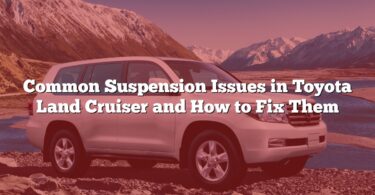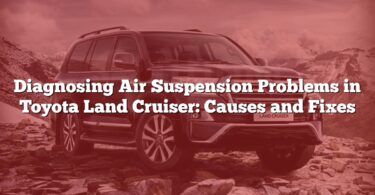Driving in hot weather can put significant stress on your Toyota Land Cruiser, sometimes leading to unexpected engine stalling. This guide explores the common causes behind this issue and provides practical solutions to keep your vehicle running smoothly. Whether it’s a faulty fuel pump, overheating, or vapor lock, understanding the root of the problem is the first step toward preventing future breakdowns.
Comprehensive Guide: Causes and Solutions for Engine Stalling in Hot Weather in a Toyota Land Cruiser
| N° | Problem | Solution |
|---|---|---|
| 1 | Fuel pump failure | Replace the faulty fuel pump. |
| 2 | Vapor lock in the fuel system | Insulate fuel lines and avoid prolonged idling in extreme heat. |
| 3 | Faulty fuel injectors | Clean or replace fuel injectors as needed. |
| 4 | Malfunctioning mass airflow sensor (MAF) | Clean or replace the MAF sensor. |
| 5 | Clogged fuel filter | Replace the fuel filter. |
| 6 | Engine overheating | Check and repair the cooling system; refill coolant. |
| 7 | Faulty ignition coil | Replace the ignition coil. |
| 8 | Weak or failing battery | Test and replace the battery if necessary. |
| 9 | Alternator malfunction | Replace the alternator. |
| 10 | Dirty or faulty throttle body | Clean the throttle body or replace it if faulty. |
| 11 | Malfunctioning oxygen sensors | Replace the oxygen sensors. |
| 12 | Faulty crankshaft position sensor | Replace the crankshaft position sensor. |
| 13 | Damaged or loose vacuum hoses | Inspect, repair, or replace vacuum hoses. |
| 14 | Clogged air filter | Replace the air filter. |
| 15 | Malfunctioning camshaft position sensor | Replace the camshaft position sensor. |
| 16 | Defective engine control module (ECM) | Diagnose and replace the ECM if necessary. |
| 17 | Overheated transmission | Service the transmission and ensure proper cooling. |
| 18 | Low-quality or contaminated fuel | Drain the fuel tank and refill with high-quality fuel. |
| 19 | Faulty EGR valve | Clean or replace the EGR valve. |
| 20 | Wiring or electrical issues | Inspect and repair wiring; replace damaged components. |
| 21 | Faulty spark plugs | Replace the spark plugs. |
| 22 | Incorrect spark plug gap | Adjust the spark plug gap to specifications. |
| 23 | Weak fuel pressure regulator | Replace the fuel pressure regulator. |
| 24 | Sensor overheating | Replace affected sensors and ensure proper engine cooling. |
| 25 | Radiator or cooling system failure | Repair or replace the radiator; flush and refill the cooling system. |
| 26 | Malfunctioning idle air control valve (IACV) | Clean or replace the IACV. |
| 27 | Air conditioning system load | Reduce A/C load during extreme heat or inspect A/C compressor. |
| 28 | Exhaust manifold leak | Repair or replace the exhaust manifold. |
| 29 | Faulty temperature sensors | Replace temperature sensors. |
| 30 | Excessive engine load | Avoid overloading the vehicle; reduce cargo or towing weight. |
| 31 | Faulty timing belt or chain | Replace the timing belt or chain as per manufacturer’s guidelines. |
| 32 | Faulty PCV valve | Replace the PCV valve. |
| 33 | Engine oil overheating | Use appropriate oil grade; check and maintain oil levels. |
| 34 | Low oil pressure | Diagnose and repair the oil pump or address internal engine wear. |
| 35 | Rapid fuel boiling due to high temperature | Install a fuel cooler or drive during cooler parts of the day. |
| 36 | Increased vapor in the fuel tank | Vent the fuel tank properly or replace the fuel cap. |
| 37 | Abrupt decrease in fuel tank inner pressure | Ensure proper venting and check the fuel pressure regulator. |
| 38 | Impact of boiling point and vapor pressure on fuel | Use fuel with a higher boiling point in hot climates. |
| 39 | Weathering of fuel properties | Store fuel in a cool place and avoid using old or degraded fuel. |
Detailed Guide: Causes and Solutions for Engine Stalling in Hot Weather in a Toyota Land Cruiser
1. Fuel Pump Failure
- Reason 1: Wear and tear can cause the fuel pump to lose its ability to supply consistent fuel pressure.
- Reason 2: Overheating of the pump due to hot ambient temperatures can lead to failure.
Solution: Replace the fuel pump with a new one.
- Step 1: Disconnect the battery and remove the fuel tank.
- Step 2: Detach the old fuel pump and install a compatible replacement.
- Step 3: Reconnect all components and test the fuel pressure.
2. Vapor Lock in the Fuel System
- Reason 1: High temperatures can cause gasoline to vaporize, creating a blockage in the fuel lines.
- Reason 2: Poor insulation of fuel lines exacerbates vapor lock.
Solution: Insulate the fuel lines with heat-resistant materials.
- Step 1: Identify exposed fuel lines near heat sources.
- Step 2: Wrap the lines with heat-resistant tape or sleeves.
- Step 3: Avoid prolonged idling in extreme heat.
3. Faulty Fuel Injectors
- Reason 1: Clogging from dirt or debris reduces fuel flow.
- Reason 2: Electrical failure in the injector prevents proper fuel delivery.
Solution: Clean or replace fuel injectors.
- Step 1: Use a fuel injector cleaner added to the fuel tank.
- Step 2: If the issue persists, remove and clean or replace the injectors.
4. Malfunctioning Mass Airflow Sensor (MAF)
- Reason 1: Dirt or debris on the sensor distorts airflow readings.
- Reason 2: Electrical faults cause incorrect data transmission to the ECU.
Solution: Clean or replace the MAF sensor.
- Step 1: Disconnect the sensor and clean it with MAF sensor cleaner.
- Step 2: Reinstall or replace the sensor if cleaning does not resolve the issue.
5. Clogged Fuel Filter
- Reason: Dirt or debris accumulated over time blocks fuel flow.
Solution: Replace the fuel filter.
- Step 1: Locate the fuel filter under the vehicle or in the engine bay.
- Step 2: Detach the old filter and install a new one. Ensure the fuel flow direction matches.
6. Engine Overheating
- Reason 1: Insufficient coolant levels or leaks in the cooling system.
- Reason 2: Faulty radiator or water pump.
Solution: Address cooling system issues.
- Step 1: Inspect for coolant leaks and refill coolant as needed.
- Step 2: Test and replace the radiator or water pump if defective.
7. Faulty Ignition Coil
- Reason: A failing ignition coil cannot provide adequate spark for combustion.
Solution: Replace the ignition coil.
- Step 1: Test the ignition coil with a multimeter.
- Step 2: Replace the coil if readings are outside specifications.
8. Weak or Failing Battery
- Reason: A weak battery cannot supply sufficient power to the engine.
Solution: Replace the battery.
- Step 1: Test the battery voltage with a multimeter.
- Step 2: Replace the battery if the voltage is below acceptable levels.
9. Alternator Malfunction
- Reason: A failing alternator cannot recharge the battery or power the engine.
Solution: Replace the alternator.
- Step 1: Check the alternator output with a voltmeter.
- Step 2: Replace the alternator if it fails the test.
10. Dirty or Faulty Throttle Body
- Reason: Carbon buildup prevents proper airflow into the engine.
Solution: Clean the throttle body.
- Step 1: Remove the throttle body and clean it with throttle body cleaner.
- Step 2: Reinstall it and test for improved performance.
11. Malfunctioning Oxygen Sensors
- Reason: Faulty sensors provide incorrect air-fuel ratio data to the ECU.
Solution: Replace the oxygen sensors.
- Step 1: Locate the sensors in the exhaust system.
- Step 2: Remove and replace them with compatible parts.
12. Faulty Crankshaft Position Sensor
- Reason: A failing sensor causes timing issues in the engine.
Solution: Replace the crankshaft position sensor.
- Step 1: Locate the sensor near the crankshaft pulley.
- Step 2: Disconnect and replace the sensor with a new one.
13. Damaged or Loose Vacuum Hoses
- Reason: Leaks in vacuum hoses disrupt engine air balance.
Solution: Repair or replace damaged hoses.
- Step 1: Inspect hoses for cracks or disconnections.
- Step 2: Reattach loose hoses or replace damaged sections.
14. Clogged Air Filter
- Reason: Dirt in the filter restricts airflow into the engine.
Solution: Replace the air filter.
- Step 1: Remove the old air filter from the housing.
- Step 2: Insert a new filter and secure the housing.
15. Malfunctioning Camshaft Position Sensor
- Reason: Sensor failure disrupts timing and valve control.
Solution: Replace the camshaft position sensor.
- Step 1: Disconnect and remove the sensor.
- Step 2: Install a new sensor and test the system.
16. Defective Engine Control Module (ECM)
- Reason: Faulty ECM can misinterpret data or fail to regulate engine performance.
Solution: Diagnose and replace the ECM if necessary.
- Step 1: Use a diagnostic tool to confirm ECM malfunction.
- Step 2: Replace the ECM with a compatible unit and reprogram it according to manufacturer specifications.
17. Overheated Transmission
- Reason: High temperatures can impair transmission function, putting extra strain on the engine.
Solution: Service the transmission and ensure proper cooling.
- Step 1: Check the transmission fluid level and quality; replace if degraded.
- Step 2: Inspect the transmission cooler and ensure adequate airflow or cooling system operation.
18. Low-Quality or Contaminated Fuel
- Reason: Poor fuel quality or contamination can hinder combustion.
Solution: Drain the fuel tank and refill with high-quality fuel.
- Step 1: Empty the fuel tank and dispose of contaminated fuel safely.
- Step 2: Refill with high-octane, clean fuel suitable for your vehicle.
19. Faulty EGR Valve
- Reason: A stuck or malfunctioning EGR valve disrupts exhaust gas recirculation, causing stalling.
Solution: Clean or replace the EGR valve.
- Step 1: Remove the valve and clean it with a carburetor cleaner.
- Step 2: Replace the valve if cleaning does not restore function.
20. Wiring or Electrical Issues
- Reason: Damaged or corroded wiring affects sensor and engine control signals.
Solution: Inspect and repair electrical wiring.
- Step 1: Use a multimeter to test continuity in suspected circuits.
- Step 2: Repair or replace damaged wires or connectors.
21. Faulty Spark Plugs
- Reason: Worn or damaged spark plugs fail to ignite the air-fuel mixture.
Solution: Replace the spark plugs.
- Step 1: Remove old spark plugs and check for wear or damage.
- Step 2: Install new spark plugs, ensuring they are correctly gapped.
22. Incorrect Spark Plug Gap
- Reason: An improper gap reduces ignition efficiency.
Solution: Adjust the spark plug gap to specifications.
- Step 1: Use a spark plug gap tool to measure the gap.
- Step 2: Adjust to the manufacturer’s recommended setting.
23. Weak Fuel Pressure Regulator
- Reason: A faulty regulator causes inconsistent fuel pressure.
Solution: Replace the fuel pressure regulator.
- Step 1: Locate the regulator on the fuel rail.
- Step 2: Replace it with a new unit and test the fuel pressure.
24. Sensor Overheating
- Reason: Excessive heat affects sensor performance.
Solution: Replace affected sensors and ensure proper engine cooling.
- Step 1: Identify and replace the overheated sensor.
- Step 2: Check the cooling system to prevent future overheating.
25. Radiator or Cooling System Failure
- Reason: A malfunctioning radiator or cooling system leads to engine overheating.
Solution: Repair or replace the radiator and flush the cooling system.
- Step 1: Inspect for leaks or blockages in the radiator.
- Step 2: Replace faulty components and refill with fresh coolant.
26. Malfunctioning Idle Air Control Valve (IACV)
- Reason: A dirty or stuck IACV disrupts idle stability.
Solution: Clean or replace the IACV.
- Step 1: Remove and clean the valve with a throttle body cleaner.
- Step 2: Replace it if cleaning does not restore normal idle.
27. Air Conditioning System Load
- Reason: Excessive load from the A/C compressor strains the engine.
Solution: Reduce A/C load or inspect the compressor.
- Step 1: Avoid using maximum A/C settings in extreme heat.
- Step 2: Inspect and service the A/C system if performance remains poor.
28. Exhaust Manifold Leak
- Reason: Leaks in the exhaust manifold cause uneven backpressure.
Solution: Repair or replace the exhaust manifold.
- Step 1: Locate the leak using a smoke test.
- Step 2: Seal the leak or replace the manifold if damaged.
29. Faulty Temperature Sensors
- Reason: Defective sensors provide inaccurate temperature readings.
Solution: Replace the temperature sensors.
- Step 1: Identify and remove the faulty sensor.
- Step 2: Install a new sensor and test the system.
30. Excessive Engine Load
- Reason: Overloading the vehicle places undue strain on the engine.
Solution: Reduce cargo or towing weight.
- Step 1: Review the vehicle’s weight limits in the manual.
- Step 2: Avoid exceeding these limits to maintain engine performance.
31. Faulty Timing Belt or Chain
- Reason: A worn or broken belt/chain disrupts engine timing.
Solution: Replace the timing belt or chain.
- Step 1: Follow the manufacturer’s replacement interval.
- Step 2: Replace the timing belt or chain with an OEM part.
32. Faulty PCV Valve
- Reason: A stuck PCV valve disrupts pressure regulation in the engine.
Solution: Replace the PCV valve.
- Step 1: Locate the PCV valve on the engine.
- Step 2: Replace it with a new one and test engine performance.
33. Engine Oil Overheating
- Reason: Inappropriate oil grade or low levels cause overheating.
Solution: Use the correct oil grade and maintain proper levels.
- Step 1: Check the oil level and top up if needed.
- Step 2: Use oil specified by the manufacturer for hot climates.
34. Low Oil Pressure
- Reason: Faulty oil pump or engine wear reduces oil pressure.
Solution: Diagnose and repair the oil system.
- Step 1: Test oil pressure with a gauge.
- Step 2: Replace the oil pump or address engine wear as needed.
35. Rapid Fuel Boiling Due to High Temperature
- Reason: High temperatures cause gasoline to vaporize excessively.
Solution: Install a fuel cooler or avoid driving in peak heat.
- Step 1: Fit a fuel cooler to the fuel line.
- Step 2: Plan trips during cooler times of the day.
36. Increased Vapor in the Fuel Tank
- Reason: Excessive vapor disrupts fuel flow.
Solution: Vent the fuel tank or replace the fuel cap.
- Step 1: Ensure the fuel cap is vented or replace it.
- Step 2: Check the fuel tank pressure relief system.
37. Abrupt Decrease in Fuel Tank Inner Pressure
- Reason: Sudden pressure drops increase fuel vaporization.
Solution: Check venting and the fuel pressure regulator.
- Step 1: Inspect the fuel tank venting system for blockages.
- Step 2: Replace the pressure regulator if faulty.
38. Impact of Boiling Point and Vapor Pressure on Fuel
- Reason: Low boiling point fuels vaporize more in hot conditions.
Solution: Use fuel with a higher boiling point.
- Step 1: Purchase fuel recommended for high-temperature climates.
39. Weathering of Fuel Properties
- Reason: Old or improperly stored fuel degrades, causing engine issues.
Solution: Use fresh fuel and store it properly.
- Step 1: Avoid using fuel stored for extended periods.
- Step 2: Store fuel in sealed, cool conditions.
Preventing Future Issues
Taking proactive measures can help ensure your Toyota Land Cruiser runs smoothly in hot weather and prevent engine stalling. Follow these steps to maintain optimal engine performance:
- Regular Maintenance:
Schedule periodic maintenance to check key components such as the fuel pump, ignition system, sensors, and cooling system. Address any wear and tear before it becomes a problem. - Inspect and Replace Filters:
- Check the air and fuel filters regularly for clogs or dirt.
- Replace them as needed to maintain proper airflow and fuel delivery.
- Use High-Quality Fuel:
Always refuel with high-quality gasoline that meets or exceeds the manufacturer’s recommendations. Avoid using old or contaminated fuel. - Monitor Coolant Levels:
Ensure the cooling system has sufficient coolant, especially during hotter months. Flush and refill the coolant system at recommended intervals. - Check the Battery and Electrical System:
- Inspect the battery for corrosion or weak charge.
- Test and replace aging batteries and inspect wiring for any damage.
- Avoid Overloading the Vehicle:
Minimize excess weight, especially when driving in high temperatures. Adhere to the recommended cargo and towing limits specified by the manufacturer. - Protect Fuel Lines from Heat:
Insulate fuel lines near high-temperature engine components to prevent vapor lock and fuel boiling. - Monitor and Replace Sensors:
Periodically check sensors such as the mass airflow sensor (MAF), oxygen sensors, and temperature sensors. Replace them if they show signs of malfunction. - Plan Trips During Cooler Times:
When possible, avoid driving during peak heat hours. Early morning or late evening trips can help reduce strain on the engine. - Upgrade Engine Components:
- Consider upgrading parts such as the radiator or installing a fuel cooler for added performance in hot climates.
- Use oil grades suited for high-temperature driving as specified in the owner’s manual.
By following these steps, you can minimize the risk of engine stalling and extend the lifespan of your Land Cruiser. Regular care and attention to your vehicle will ensure it remains reliable even in extreme weather conditions.







